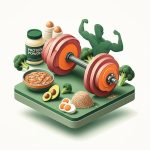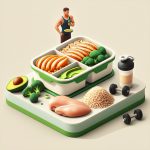Pollock: is it a nutritious choice? This common and affordable fish is widely available, but is it truly beneficial for your health? This comprehensive guide explores the nutritional benefits and potential risks of pollock, offering practical advice for selecting and preparing it. For a deeper dive into pollock’s health benefits, check out this detailed guide. Let’s determine if pollock deserves a regular spot on your menu.
Pollock Fish: Unveiling the Health Benefits and Nutritional Facts
Let’s examine pollock, a mild-flavored white fish increasingly found in grocery stores. Is it a genuinely healthy option? The answer is nuanced. Like all foods, it’s essential to be informed. This guide provides a balanced perspective on pollock, spotlighting its nutritional advantages and potential disadvantages, empowering you to make well-informed dietary decisions.
Pollock Nutrition: A Deep Dive into Its Nutritional Value
Pollock is a lean protein source, meaning it’s high in protein while being relatively low in fat and calories, a factor that can contribute to effective weight management. A 3-ounce (85-gram) serving provides approximately 20 grams of protein, making a considerable contribution to your daily protein requirements. Pollock is also a valuable source of vitamin B12, essential for neurological function and the formation of red blood cells, and selenium, an antioxidant that helps protect cells from damage caused by free radicals. While pollock does contain omega-3 fatty acids, the quantity is moderate compared to richer sources like salmon or mackerel.
A key consideration is the distinction between Alaskan and Atlantic pollock. Alaskan pollock generally receives more favorable sustainability ratings, indicating responsible harvesting practices that minimize environmental impact. When possible, prioritize sustainably sourced pollock to support healthy ocean ecosystems.
Here’s a summary of pollock’s nutrient content (approximate values for a 3-ounce/85-gram serving):
| Nutrient | Amount per 3-ounce serving (Approximate) |
|---|---|
| Protein | 20 grams |
| Calories | 70-90 |
| Fat | 1 gram |
| Vitamin B12 | Good Source (Variable, check label) |
| Selenium | Good Source (Variable, check label) |
| Omega-3 Fatty Acids | Moderate Amount (around 0.2-0.3 grams) |
| Phosphorus | 25% Daily Value |
Note: Nutritional values can vary based on the specific preparation method and source of the fish. Always check the nutritional label.
Pollock Health Benefits: Exploring the Advantages of Consumption
Research suggests that including pollock in your diet can offer several health advantages. The high protein content promotes satiety, which can be beneficial for weight management (“a 3-ounce serving offers around 20 grams of protein”). Vitamin B12 supports healthy brain function, while selenium acts as an antioxidant, protecting cells from damage. Some studies have indicated a potential link between pollock consumption and improved heart health, but further research is needed to confirm these findings. Similarly, there is growing interest in the potential positive impact of pollock on cognitive function, an area that warrants further investigation.
It’s important to remember that these benefits are generally observed as part of an overall balanced and varied diet, rather than solely from the consumption of pollock.
Potential Risks and Considerations When Eating Pollock Fish
While pollock is generally considered safe, awareness of potential risks is essential. Mercury levels are typically low, especially in Alaskan pollock, but it’s still prudent to monitor your overall seafood mercury intake. Prioritize sustainability by seeking certifications for responsibly-sourced pollock, helping to minimize the environmental impact of fishing practices. As with any food, allergic reactions are possible, although relatively rare. If you have known seafood allergies, exercise caution and consult with a healthcare provider before consuming pollock.
The cooking method used can significantly influence pollock’s nutritional profile. Overcooking can diminish its nutrient content and negatively affect its texture and flavor. Opt for gentle cooking techniques to preserve both the flavor and nutritional value of the fish.
Additionally, the sodium content can be a concern, particularly in processed pollock products like fish sticks or imitation crab meat. Always check the nutrition label and choose low-sodium options whenever possible.
Actionable Steps: Expert Tips for Choosing, Cooking, and Eating Pollock
Here’s how to maximize pollock’s dietary impact while minimizing potential risks:
- Choose Wisely: Opt for sustainably sourced pollock, ideally Alaskan pollock bearing certifications from reputable organizations that verify sustainable fishing practices, such as the Marine Stewardship Council (MSC).
- Cook it Right: Utilize healthy cooking methods like baking, grilling, steaming, poaching or pan-frying with minimal oil to cook pollock, preserving its nutrients and flavor. Avoid overcooking, which can dry out the fish and reduce its nutritional value.
- Incorporate it Mindfully: Aim for one to two servings of pollock per week as part of a varied and balanced diet rich in fruits, vegetables, and whole grains. Don’t rely solely on pollock for all your nutritional needs.
- Check the Label: Pay attention to sodium content, especially in processed pollock products.
- Be Aware of Allergies: If you have seafood allergies, consult with your doctor before trying pollock.
Pollock: Is it a Healthy Choice for You?
Ultimately, whether pollock is a healthy choice depends on various factors, including sourcing, preparation methods, and individual dietary needs and sensitivities. When thoughtfully integrated into a well-rounded diet, pollock can be a nutritious and versatile fish that provides lean protein, essential vitamins, and minerals. By choosing sustainable options, employing healthy cooking techniques, and diversifying your diet, you can enjoy the benefits of this accessible and affordable seafood. Stay informed about ongoing research findings in nutrition science to make the best possible choices for your health.
How to Cook Pollock to Maximize Omega-3s and Nutrients: A Culinary Guide
Key Takeaways:
- Pollock is a significant source of lean protein and essential vitamins and minerals.
- Alaskan pollock generally has lower mercury levels compared to Atlantic pollock, but always check sourcing.
- Sustainable sourcing is crucial for the long-term health of our oceans.
- Proper cooking techniques help retain the fish’s beneficial nutrients.
Understanding Pollock’s Nutritional Powerhouse: A Summary
Pollock, a lean white fish, boasts a surprisingly rich nutritional profile. Its high protein content makes it a valuable asset for tissue repair and muscle building. It is also packed with vitamin B12, essential for nerve function, and selenium, an antioxidant that protects against cellular damage.
Alaskan vs. Atlantic Pollock: Making an Informed Choice
Alaskan pollock often exhibits lower mercury levels, potentially making it a safer option for regular consumption. However, regardless of the type, prioritizing sustainably sourced pollock is the most responsible choice for environmental preservation. Look for certifications like the MSC label.
The Best Cooking Methods to Maximize Omega-3s and Nutrients: A Culinary Exploration
Deep-frying can negate many of the health benefits of pollock by adding unhealthy fats and potentially destroying delicate nutrients. Instead, opt for gentler cooking methods that preserve both flavor and nutritional value:
- Baking: Season pollock fillets with herbs, spices, and a drizzle of olive oil. Bake in a preheated oven at 375°F (190°C) for 12-15 minutes, or until the fish is opaque and flakes easily with a fork.
- Steaming: Preserve moisture and nutrients by steaming pollock fillets for 8-10 minutes, or until cooked through. Add aromatics like ginger, lemon slices, or herbs to the steaming water for added flavor.
- Pan-Searing: Sear pollock fillets in a lightly oiled pan over medium-high heat for a flavorful and slightly crispy crust. Cook for 3-4 minutes per side, or until cooked through. Use a healthy oil like olive oil or avocado oil.
- Poaching: Simmer pollock gently in water, broth, or a flavorful sauce with seasonings and aromatics like herbs, lemon, or garlic. This method helps retain moisture and keeps the fish tender.
How to Cook Pollock to Maximize Omega-3s and Nutrients: Addressing Potential Concerns
While pollock offers numerous health benefits, it’s important to be mindful of potential concerns. Pay attention to mercury levels (choose lower-mercury options), prioritize sustainable sourcing (look for certifications), and be aware of potential allergic reactions.
Integrating Pollock into Your Diet: Practical Tips and Ideas
Aim to include seafood in your diet at least twice a week. Incorporate pollock into your meals in creative and delicious ways:
- Grilled Pollock Tacos: Flake grilled pollock and serve in warm tortillas with your favorite taco toppings.
- Baked Pollock with Roasted Vegetables: Bake pollock fillets alongside a medley of colorful roasted vegetables like broccoli, carrots, and bell peppers.
- Pollock Stir Fry: Add chunks of pollock to a vegetable stir fry in the last few minutes of cooking.
Proven Tactics For Integrating Pollock Into Your Diet: A Practical Guide
Key Takeaways:
- Pollock is a lean protein source, low in calories and saturated fat, making it a great choice for weight management.
- It’s a good source of Vitamin B12 and selenium, which are essential for brain and heart health.
- Alaskan pollock generally has lower mercury levels than Atlantic pollock, but always check the source.
- Prioritizing sustainable sourcing is crucial; choose responsibly harvested pollock whenever possible.
- Cooking methods greatly impact nutrient retention; opt for healthier options.
- Consider incorporating pollock into a balanced diet to reap its optimal health benefits.
Understanding Pollock’s Nutritional Profile: What Makes It a Good Choice
Pollock, a widely available white fish, provides a valuable nutritional profile. A typical serving offers a substantial amount of protein. It’s also relatively low in calories, making it an ideal choice for those focused on weight management. Pollock contains Vitamin B12, vital for nerve function and cellular metabolism, and selenium, a potent antioxidant that helps protect cells from damage.
Health Benefits: Exploring What Pollock Brings to the Table
The high-quality protein in pollock keeps you feeling full and satisfied, which can aid in weight management. Vitamin B12 plays a critical role in numerous bodily functions, especially nerve health and energy production. Selenium helps protect your cells from damage caused by free radicals. Research suggests a correlation between fish consumption, including pollock, and a reduced risk of heart disease and improved brain function, although further studies are needed to solidify these claims.
Potential Risks and Considerations: Navigating the Nuances
Mercury levels are generally low in pollock, particularly in Alaskan pollock, but it’s still wise to be mindful of your overall seafood consumption. Choose sustainably sourced pollock from fisheries certified by organizations like the Marine Stewardship Council (MSC). Allergic reactions, while uncommon, are possible. Be aware that cooking methods can significantly impact pollock’s nutritional value.
Practical Techniques for Integrating Pollock into Your Diet
Here’s how to effectively incorporate pollock into a healthy eating plan:
- Prioritize Sustainable Sources: Look for pollock that is certified by reputable organizations dedicated to sustainable fishing practices.
- Embrace Versatile Cooking Methods: Experiment with various cooking techniques, such as baking, grilling, steaming, poaching, or pan-frying with minimal oil.
- Incorporate Pollock into Weekly Meals: Aim to include 1-2 servings of pollock in your diet each week as part of a well-rounded and balanced eating plan.
- Monitor for Allergic Reactions: If you’re trying pollock for the first time, introduce it gradually. Be vigilant for any signs of an allergic reaction, such as hives, itching, swelling, or difficulty breathing. If any symptoms develop, discontinue consumption and seek medical attention immediately.
- Nutritional Awareness: While pollock is a nutritious choice, remember that other fish, such as salmon, offer higher levels of omega-3 fatty acids.
Nutritional Comparison of Popular Fish (per 100g serving): A Detailed Overview
| Fish Type | Protein (g) | Calories | Fat (g) | Vitamin B12 (mcg) | Selenium (mcg) | Omega-3 Fatty Acids (g) |
|---|---|---|---|---|---|---|
| Pollock (Alaskan) | 17-20 | 70-90 | 0.5-1 | 1.5-2.5 | 25-35 | 0.2-0.3 |
| Salmon | 20-25 | 150-200 | 8-13 | 2.5-3.5 | 30-45 | 1.0-2.0 |
| Tuna | 25-30 | 120-150 | 1-5 | 0.5-1.5 | 40-60 | 0.5-1.0 |
| Cod | 20-23 | 70-85 | 0.5-1 | 0.8-1.2 | 20-30 | 0.1-0.2 |
Note: These values are approximate and can vary depending on the specific species, preparation method, and sourcing of the fish. It’s always best to check the nutritional label for the most accurate information.
Pollock vs Other Fish- A Nutritional Comparison: Making Informed Choices
Is pollock a beneficial choice compared to other fish varieties? Let’s dive into a nutritional comparison to find out!
Understanding Pollock’s Nutritional Profile: A Quick Recap
Pollock, a lean white fish, stands out as a fantastic source of high-quality protein. In addition to its protein content, pollock provides selenium, which acts as an antioxidant, helping to defend against cell damage (“Pollock vs Other Fish- A Nutritional Comparison often highlights differences in fatty acid content”). It’s also a good source of vitamin B12.
Here’s a simplified nutritional comparison (keep in mind that exact values can fluctuate based on several factors, including sourcing and preparation methods):
| Nutrient | Pollock (approx. per 3 oz/85g) | Salmon (approx. per 3 oz/85g) | Cod (approx. per 3 oz/85g) |
|---|---|---|---|
| Protein (grams) | 17-20 | 17-20 | 15-18 |
| Fat (grams) | 0.5-1 | 6-8 | 0.5-1 |
| Omega-3s (grams) | 0.2-0.3 | 1.0-2.0 | 0.1-0.2 |
| Selenium (mcg) | 25-35 | 25-35 | 20-30 |
| Vitamin B12 (mcg) | 1.5-2.5 | 2.5-3.5 | 0.5-1.0 |
It’s always a good practice to consult nutrition labels for the most up-to-date and accurate information.
Health Benefits of Eating Pollock: A Deeper Look
Pollock’s protein contributes to feelings of fullness, which can be helpful for weight management. The selenium it provides helps combat cell damage, potentially reducing the risk of certain cancers and chronic diseases. The vitamin B12 is essential for maintaining healthy nerve function and supporting energy production.
Potential Downsides and Considerations: What to Keep in Mind
Mercury levels in pollock tend to be lower compared to larger, predatory fish. However, it’s still advisable to prioritize sustainably sourced pollock to minimize environmental impact. The cooking method you choose can also influence the nutritional content of pollock—steaming, baking, or grilling are generally healthier options than frying. The sodium content of processed pollock products can also be a concern.
Choosing and Preparing Pollock Wisely: Practical Tips
When possible, opt for Alaskan pollock over Atlantic pollock, and always prioritize sustainable fishing practices. Look for certifications from reputable organizations like the Marine Stewardship Council (MSC). Select fresh or frozen pollock that appears firm and has a mild, fresh smell. Prepare it using healthy cooking methods such as baking, grilling, steaming, or poaching.
Key Takeaways:
- Pollock offers a lean source of protein, along with selenium and vitamin B12.
- It’s a lower-fat alternative to some other popular fish varieties.
- Prioritizing sustainable sourcing is essential for environmental responsibility.
- Choosing healthy cooking methods helps preserve the fish’s valuable nutrients.
- Pollock vs Other Fish- A Nutritional Comparison highlights the diverse nutritional profiles of different fish, allowing you to tailor your choices to meet your specific dietary needs and preferences.
- Gluten Free Meal Prep Ideas for Delicious, Hassle-Free Eating - November 28, 2025
- Gluten Free Meal Prep for Stress-Free and Healthy Eating - November 27, 2025
- Quick And Easy Chicken Thigh Meal Prep For Weight Loss - November 26, 2025










